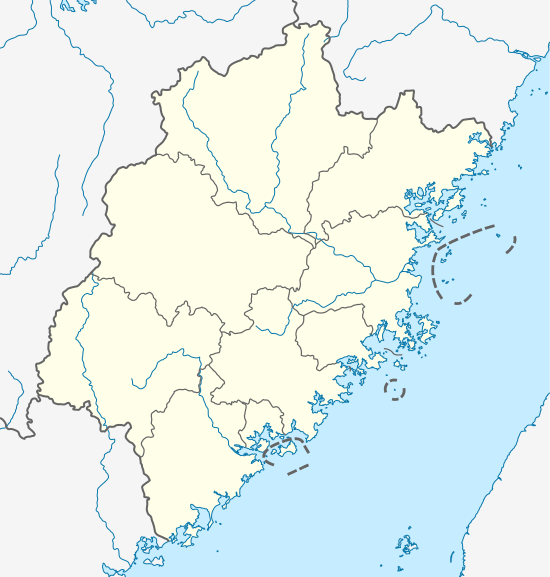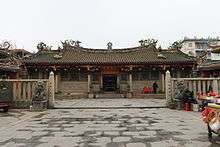Longshan Temple (Jinjiang)
| Longshan Temple | |
|---|---|
| 龙山寺 | |
 A censer in front of a hall at Longshan Temple. | |
 Shown within Fujian  Longshan Temple (Jinjiang) (China) | |
| Basic information | |
| Location | Anhai Town, Jinjiang, Fujian |
| Geographic coordinates | 24°43′43″N 118°28′23″E / 24.728749°N 118.473053°ECoordinates: 24°43′43″N 118°28′23″E / 24.728749°N 118.473053°E |
| Affiliation | Buddhism |
| Deity | Chan Buddhism |
| Country | China |
| Architectural description | |
| Architectural style | Chinese architecture |
| Date established | 618–619 |
| Completed | 1708 (reconstruction) |
Longshan Temple (simplified Chinese: 龙山寺; traditional Chinese: 龍山寺; pinyin: Lóngshān Sì) is a Buddhist temple located on the foot of Mount Long (龙山; "Dragon Mountain") in Anhai Town of Jinjiang, Fujian, China.[1] The eldest thing in the temple is the statue of Thousand-armed and eyed Guanyin, which was supposed carved by ancient Indian monk Yilisha (一粒沙).[2] It was transformed and expanded many times throughout Chinese history till now. There are dozens of which are built after the Ming dynasty (1368–1644). Longshan Temple is the ancestral temple of 400 Buddhist temples with the same name in Taiwan.[3][4]
History

Tang dynasty
Longshan Temple was originally built between 618 and 619, at the dawn of the Tang dynasty (618–907). It initially called "Puxian Temple" (普现寺) and "Tianzhu Temple" (天竺寺; "Temple of Tianzhu (India)"), more commonly known as the "Guanyin Hall" (观音殿).[5]
Ming dynasty
The present version was completed in 1623, during the reign of Tianqi Emperor (1621–1627) in the late Ming dynasty (1368–1644).[5]
Qing dynasty
In 1684, in the 23rd year of Kangxi period (1662–1722) in the Qing dynasty (1644–1911), Shi Lang appropriated a large sum of money for constructing buildings of the temple. And the temple was largely extended in 1708.[5]
People's Republic of China
Longshan Temple has been designated as a National Key Buddhist Temple in Han Chinese Area by the State Council of China in 1983.
In May 2013, Longshan Temple was listed among the seventh group of "Major National Historical and Cultural Sites in Fujian" by the State Council of China.[2]
Architecture
Hall of Four Heavenly Kings
The Hall of Four Heavenly Kings is the frontal hall in the temple, for the worship of Four Heavenly Kings, namely the eastern Dhṛtarāṣṭra, the southern Virūḍhaka, the western Virūpākṣa and the northern Vaiśravaṇa.[5]
Mahavira Hall
The Mahavira Hall is with double-eave gable and hip roof. A gilded copper statue of Sakyamuni are enshrined in the middle of the hall.[5]
Yuantong Hall
The Yuantong Hall (圆通宝殿) is the main hall in the temple. It was first built in the Sui dynasty (589–618) and rebuilt in the late Qing dynasty (1644–1911). The hall is 11.8-metre (39 ft) high, five rooms wide, three rooms deep and covers an area of 483-square-kilometre (186 sq mi). The hall has double-eave gable and hip roof. On each end of the main ridge is a giant glazed green Chinese dragon, which known as Chiwen in Chinese architecture. There is a pair of 10-meter stone pillars with dragon patterns carved on it. The two lively dragons face each other and seem to fight against each other.[5]
The Yuantong Hall enshrining a wood carving statue of Thousand-armed and eyed Guanyin. It is 4.2-metre (14 ft) high with 1,008 arms on both sides of the body. The middle two hands are in closing palm posture and other hands are holding Vajras, sutra scrolls Dharma seals and other weapons. There are several small statues of Buddha on its head.[5]
Television series
Longshan Temple was used for location filming of 2015 documentary Longshan Temple.[6]
References
- ↑ "Longshan Temple". jinjiang.gov.cn. 26 August 2015. Retrieved 15 May 2018.
- 1 2 安海龙山寺:一道山门隔出两个世界 四百多座子寺遍布台湾. iFeng (in Chinese). 2014-11-06.
- ↑ 探访台湾四百多座龙山寺的祖庙——福建龙山寺. chinanews.com (in Chinese). 2016-12-21.
- ↑ 台湾四百龙山寺溯本逐源在安海(图). 163.com (in Chinese). 2014-12-19.
- 1 2 3 4 5 6 7 "Longshan Temple in Jinjiang". chinabuddhism.com.cn (in Chinese). 2012-03-13.
- ↑ 讲述海峡两岸佛缘传奇纪录片《龙山寺》在台湾播出. taiwan.cn (in Chinese). 2015-05-28.